The
Paleozoic (meaning "time of ancient life)" Era lasted
from 544 to 245 million years ago, and is divided into six
periods. These 300 million years of the Paleozoic era realized
many critical events in evolution, including the development
of most invertebrate groups, life's conquest of land, the evolution
of fish, reptiles, insects, and vascular plants, the formation
of the supercontinent of Pangea. Fish and fish-like vertebrates
arose in the early Paleoozoic and comprise more than half of
the diversity of vertebrates that inhabit the world today.
Also importantly, there were also no less than two ice ages
in the Paleozoic. The Paleozoic was ended by the greatest mass
extinction event in geologic history, the Permian/Triassic
extinction, when some 95% of all marine species met extincttion.
The
name Cambrian derives from Cambria, the Roman name for Wales,
where rocks of this age were first studied. Hard-shelled animals
appeared in great numbers for the first time during the Cambrian,
significantly because shallow seas flooded the continents. Gondwana
formed near the South Pole.
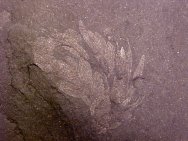 The
Cambrian truly is an astonishing period in evolution of life on
earth. Most major groups of animals first appear in the fossil
record, an event popularly and scientifically called the "Cambrian
Explosion". The name largely derives from the
hypothesized explosion of diversity of life that occurred very
rapidly, but that this actually occurred is not a consensus among
scientists. Darwin and others once believed that the Cambrian
rocks contained the first and oldest fossil animals. We now know
that these occur in the earlier Vendian strata. The
Cambrian truly is an astonishing period in evolution of life on
earth. Most major groups of animals first appear in the fossil
record, an event popularly and scientifically called the "Cambrian
Explosion". The name largely derives from the
hypothesized explosion of diversity of life that occurred very
rapidly, but that this actually occurred is not a consensus among
scientists. Darwin and others once believed that the Cambrian
rocks contained the first and oldest fossil animals. We now know
that these occur in the earlier Vendian strata.
Many
marine metazoans
having mineralized exoskeletons flourish in the Cambrian, including
sponges, corals,
molluscs, echinoderms,
bryozoans, brachiopods
and arthropods.
It is commonly believed that there were no organisms at the very
base of Cambrian that had hard parts, either as an external skeleton
or simply spicules. This is, however, remains in dispute. The
first shelled metazoans that are characteristic of the Cambrian
occur well after the earliest complex trace fossils. This suggests
that hard parts evolved later. Hence, trilobites, archaeocyaths,
and small shelly animals did
not evolve before the middle part of the Early Cambrian. The evolution
of shelled metazoans is reflected by the appearence of successively
more advanced shelly fossils.
Trilobites
dominate the Cambrian fossil record, and these arthropods
actually attained their peak number of families near the end of
the Cambrian. It is believed there were some 15,000 species that
evolved during the Paleozoic. Hence, the Paleozoic is sometimes
called the age of trilobites. Modern times are sometimes called
the age of insects
(that are also arthropods), and it is believed there may be some
10,000,000 species of insects on Earth today (with beetles predominating).
The
first detailed record of vertebrates appears during the Cambrian
as fossils of jawless fish. These bottom-dwellers, some of which
had skeletons made of cartilage rather than bone, first appeared
some 500 million years ago. Many were covered in plate-like armour.
When
one thinks of the migration of animals from the marine environment
to land, Devonian-time comes to mind. But, in fact, the fossil
record has substantial evidence that this critical adaptation
had already begun in the Cambrian. One of these fossils, Climactichnites
is almost as enigmatic today as it was during the time of Darwin.
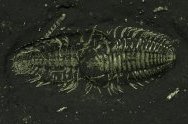 The
Ordvician is named after a Celtic tribe called the Ordovices,
and was a time that life diversified and specialized. Owing to
continental separation, trilobites drifted apart genetically taking
on new, location-dependent forms, some quite exotic. The first
planktonic graptolites evolved, and other graptolite species became
extinct. Most profound perhaps was the colonization of land. Terrestrial
arthropod fossils occur in Ordovician strata, as do microfossils
of the cells, cuticle, and spores of the early land-based plants. The
Ordvician is named after a Celtic tribe called the Ordovices,
and was a time that life diversified and specialized. Owing to
continental separation, trilobites drifted apart genetically taking
on new, location-dependent forms, some quite exotic. The first
planktonic graptolites evolved, and other graptolite species became
extinct. Most profound perhaps was the colonization of land. Terrestrial
arthropod fossils occur in Ordovician strata, as do microfossils
of the cells, cuticle, and spores of the early land-based plants.
Ordovician
strata are characterized by numerous and diverse trilobites and
conodonts (phosphatic fossils with a tooth-like appearance) found
in sequences of shale, limestone, dolostone, and sandstone. In
addition, blastoids, bryozoans, corals, crinoids, as well as many
kinds of brachiopods, snails, clams, and cephalopods appeared
for the first time in the geologic record in tropical Ordovician
environments. Remains of Ostracoderms (jawless, armored fish)
from Ordovician rocks comprise some of the oldest vertebrate fossils.
Despite
the appearance of coral fossils during this time, reef ecosystems
continued to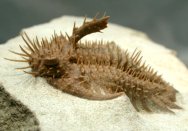 be dominated by algae and sponges, and in some cases
by bryozoans. However, there apparently were also periods of complete
global reef collapse due to global disturbances. Conodonts decreased
in the North Atlantic Realm, but new lineages appeared in other
regions. Seven major conodont lineages went extinct, but were
replaced by nine new lineages that resulted from a major evolutionary
radiation. These lineages included many new and morphologically
different taxa. Sea level transgression persisted, causing the
drowning of almost the entire Gondwana craton. The Ordovician
fossils are the oldest complete vertebrates. They were jawless,
armored fish with large bony shields on the head, and small plate-like
scales covering the tail. be dominated by algae and sponges, and in some cases
by bryozoans. However, there apparently were also periods of complete
global reef collapse due to global disturbances. Conodonts decreased
in the North Atlantic Realm, but new lineages appeared in other
regions. Seven major conodont lineages went extinct, but were
replaced by nine new lineages that resulted from a major evolutionary
radiation. These lineages included many new and morphologically
different taxa. Sea level transgression persisted, causing the
drowning of almost the entire Gondwana craton. The Ordovician
fossils are the oldest complete vertebrates. They were jawless,
armored fish with large bony shields on the head, and small plate-like
scales covering the tail.
The
Ordovician ended with a major extinction event that caused the
demise of some 60% of marine genera. A Late Ordovician glaciation
contributed to profound ecological disruption and mass extinctions.
Reef-building fauna were broadly decimated. Nearly all conodonts
disappeared in the North Atlantic Realm while only certain lineages
became extinct in the Midcontinental Realm. Trilobites were greatly
affected with the Agnostids
and the vast majority of Asaphid
trilobites meeting extinction, and many groups of echinoderms,
brachiopods, bryozoans, graptolites, and chitinozoans also disappearing.
The Atlantic Ocean closed as Europe moved towards North America.
Climatic fluctuations were extreme as glaciation continued and
became pervasive. Cold climates with icebergs abounded.
 The
Silurian, so named after a Celtic tribe called the Silures, realized
additional marked changes for Earth that affected life significantly.
Sea levels rose as the climate stabilized, at least compared to
the prior millions of years. Coral reefs made their first appearance
and expanded. Land plants evolved in the moist regions near the
Equator. The Silurian was also a remarkable time in the evolution
of fishes. Not only does this time period mark the wide and rapid
spread of jawless fish, but also the highly significant appearances
of both the first known freshwater fish as well as the first fish
with jaws, which resulted from an adaptation of an anterior gill
arch. The Silurian strata has fossils that are substantive evidence
of life on land, particularly the arthropod groups. The fossils
of the earliest of vascular plants are also prevalent. In the
oceans, there was a widespread radiation of crinoids and a continuation
of the expansion of the brachiopods. The
Silurian, so named after a Celtic tribe called the Silures, realized
additional marked changes for Earth that affected life significantly.
Sea levels rose as the climate stabilized, at least compared to
the prior millions of years. Coral reefs made their first appearance
and expanded. Land plants evolved in the moist regions near the
Equator. The Silurian was also a remarkable time in the evolution
of fishes. Not only does this time period mark the wide and rapid
spread of jawless fish, but also the highly significant appearances
of both the first known freshwater fish as well as the first fish
with jaws, which resulted from an adaptation of an anterior gill
arch. The Silurian strata has fossils that are substantive evidence
of life on land, particularly the arthropod groups. The fossils
of the earliest of vascular plants are also prevalent. In the
oceans, there was a widespread radiation of crinoids and a continuation
of the expansion of the brachiopods.
Devonian
Period (410 to 360 mya) "The Age
of Fishes" - Colonization of the land (Devonian
Fossils)
The
Devonian was a time of great change across the Tree of Life. Reef
ecosystems saw new and more varied forms,
including the ammonoids and fish. It was also a time when life
achieved the critical event of adapting to land. A time
of great transition. Two major clades of animal moved ashore and
rapidly radiated. Both the first tetrapods, or four legged 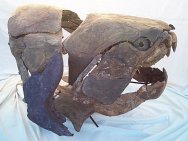 land-living
vertebrates, and the first arthropods colonized the land, including
wingless insects and the earliest arachnids. In the sea, ammonoids
and fish evolve and quickly diversify. Primitive plants that gained
a foothold in the Silurian went on to form forests. Arthropods
and ultimately tetrapods were plodding the lands. The first insects,
spiders, and tetrapods evolve. land-living
vertebrates, and the first arthropods colonized the land, including
wingless insects and the earliest arachnids. In the sea, ammonoids
and fish evolve and quickly diversify. Primitive plants that gained
a foothold in the Silurian went on to form forests. Arthropods
and ultimately tetrapods were plodding the lands. The first insects,
spiders, and tetrapods evolve.
In
the Lower Devonian, plants were very tiny and primitive, generally
lacking the leaf, root and vascular systems that would soon appear.
But plant radiation was already progressing rapidly and led to
the ferns, horsetails and seed plants. By the late Devonian earth
had forests of tall rooted trees covered with 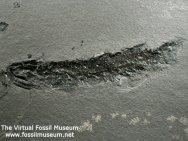 leaves.
The lycophytes (Phylum Lycopodiophyta) are the oldest extant lineage
of vascular plants e.g., club moss) and gave rise to all descending
vascular plants in a major phylogenetic split. The Lycopods that
reproduced by way of spores went on to form vast swamp forests
during the Carboniferous period with the Lepidodendrales (e.g.,
Lepidodendron) reaching heights more than 100 feet. Sigillaria
is another example of a lycopod tree. The seed-bearing Gymnosperms
appeared near the end of the Devonian, an adaptation ultimately
leading to propagation to dryer habitats. leaves.
The lycophytes (Phylum Lycopodiophyta) are the oldest extant lineage
of vascular plants e.g., club moss) and gave rise to all descending
vascular plants in a major phylogenetic split. The Lycopods that
reproduced by way of spores went on to form vast swamp forests
during the Carboniferous period with the Lepidodendrales (e.g.,
Lepidodendron) reaching heights more than 100 feet. Sigillaria
is another example of a lycopod tree. The seed-bearing Gymnosperms
appeared near the end of the Devonian, an adaptation ultimately
leading to propagation to dryer habitats.
The
Devonian is often appropriately called the "Age of Fishes",
since the fish took their place in complex reef systems containing
nautiloids, corals, graptolites, blastods, echinoderms, trilobites,
sponges, brachiopods and conodonts. With the many new forms of
predators, trilobites continue to evolve their defensive strategies.
During the Devonian, Placodermi (armored fish), Sarcopterygii
(lobe-finned fish and lungfish) and Actinopterygii
(conventional bony fish or ray-finned fish) evolved rapidly, many
of which became huge and fierce predators. Until later in the
Devonian the fishes were the only vertebrates, and gave rise to
all other  vertebrate
lineages. The first sarcopterygiians,
or the lobe-finned fish, appeared whose descendants were the first
tetrapods that also evolved before by the Uper Devonian. The class
Chondrichthyes,
the cartilaginous fish, including skates, rays, and sharks appeared
during the Devonian period. vertebrate
lineages. The first sarcopterygiians,
or the lobe-finned fish, appeared whose descendants were the first
tetrapods that also evolved before by the Uper Devonian. The class
Chondrichthyes,
the cartilaginous fish, including skates, rays, and sharks appeared
during the Devonian period.
Arthropods
radiated to become well-established on land in the Devonian, and
in some cases attained impressive size. The earliest known Hexapods
appear in the Devonian fossil record. The increasing biomass of
land plants and higher oxygen levels by the end of the Devonian
faciliated the adaption to terrestrial life of herbivorous animals.
The arthropods colonized the land, including wingless insects
and the earliest arachnids. Trilobites declined despite their
newly evolved armaments
and stealthy ways, possibly due to increasingly widespread
and ever more skillful predators.
The
Carboniferous Period derives its name from the massive deposits
of coal found in U.K. and Western Europe. In North America, the
Carboniferous is divided into the Mississippian Period and the
Pennsylvanian Period. During the Carboniferous, the continents
below the equator still formed the supercontinent Gondwana.
 Life
flourished in the seas in the wake of the late Devonian Extinction.
Ammonoids rediversified very quickly. Crinoids, blastoids, brachiopods
and bryozoans and single-celled Eukaryotes fusulinids known as
fusulinids became abundant. The ray finned fishes radiate enormously.
However, the age of the trilobite was drawing to a close. After
radiations Ordovician, Silurian, and Devonian periods, the nine
trilobite orders had shrunk to one remaining in the Carboniferous,
the Order Proetida, that too would go extinct at the end of the
Permian. Life
flourished in the seas in the wake of the late Devonian Extinction.
Ammonoids rediversified very quickly. Crinoids, blastoids, brachiopods
and bryozoans and single-celled Eukaryotes fusulinids known as
fusulinids became abundant. The ray finned fishes radiate enormously.
However, the age of the trilobite was drawing to a close. After
radiations Ordovician, Silurian, and Devonian periods, the nine
trilobite orders had shrunk to one remaining in the Carboniferous,
the Order Proetida, that too would go extinct at the end of the
Permian.
Life
on land really took root in the Carboniferous, setting the stage
for huge coal deposits to be formed in low-laying swamps. Common
in the coal producing swamps spore bearing Lycopod trees that
grew to more than 100 feet tall, Sigillaria and both spore-bearing
and seed ferns. The early wingless insect forms that appeared
in the Devonian acquire wings, and continue their radiation filling
ever-expanding environmental niches. The burial of organically
produced carbon is believed to have caused atmosphereic oxygen
to increase to concentrations 80% higher than today, and may have,
in turn, led to gigantism in some insects and amphibians whose
limited respiratory systems would have otherwise constrained thier
size.
Despite
the appearance of seeds, most Carboniferous plants continued to
use spores from reproduction. The moist and swampy environments
of the Carboniferous enabled the Lycophytes
(i.e., scale trees and club mosses)  that
evolved during the late Silurian to early Devonian to continue
to diversify and fourish throughout the Carboniferous. However,
the dependency on a moist environment caused the extinction of
most taxa during arid conditions that prevailed near the end of
the Paleozoic. Similary, Calamites and ferns were other spore-bearing
plants that appeared during the Devonian and thrived during the
following Carboniferous period. that
evolved during the late Silurian to early Devonian to continue
to diversify and fourish throughout the Carboniferous. However,
the dependency on a moist environment caused the extinction of
most taxa during arid conditions that prevailed near the end of
the Paleozoic. Similary, Calamites and ferns were other spore-bearing
plants that appeared during the Devonian and thrived during the
following Carboniferous period.
Reptiles
first appear in the Pennsylvanian, following the appearance of
amphibians in the Devonian. The amniote egg appears, an important
evolutionary invent that set the stage for further colonization
of the land by tetrapods. The ancestors of birds, mammals, and
reptiles could then reproduce on land since the embryo no longer
required an acqeous environment.
 The
Permian Period extends from about 286 to 245 million years ago,
and is the last geological period of the Palaeozoic Era. The Permian
was named in the 1840s by Sir Roderick Murchison, a British geologist,
from the extensive Permian exposures near Perm in Russia. The
Permian ended with the most extensive extinction event recorded
in paleontology: the Permian-Triassic extinction event, where
some 90% to 95% of marine organisms and 70% of all terrestrial
organisms became extinct. The
Permian Period extends from about 286 to 245 million years ago,
and is the last geological period of the Palaeozoic Era. The Permian
was named in the 1840s by Sir Roderick Murchison, a British geologist,
from the extensive Permian exposures near Perm in Russia. The
Permian ended with the most extensive extinction event recorded
in paleontology: the Permian-Triassic extinction event, where
some 90% to 95% of marine organisms and 70% of all terrestrial
organisms became extinct.
Life
on land included a diversity of plants, arthropods, amphibians
and reptiles. The reptiles were mainly synapsids (Pelycosaurs
and Therapsids) that appeared in the Upper Carboniferous, and
were bulky, cold-blooded animals with small brains Towards the
very end of the Permian the first archosaurs appear, the ancestors
of the soon to follow Triassic dinosaurs. Permian marine environments
were abundant in mollusks, echinoderms, and brachiopods.
|










